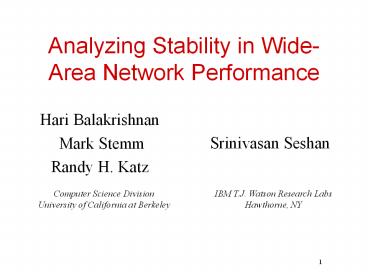Analyzing Stability in WideArea Network Performance - PowerPoint PPT Presentation
1 / 19
Title:
Analyzing Stability in WideArea Network Performance
Description:
What can we learn about real-world network performance from packet-level traces ... Basic Tool: Quantile-Quantile Plot. Low mean-squared error. Slope close to 1 ... – PowerPoint PPT presentation
Number of Views:34
Avg rating:3.0/5.0
Title: Analyzing Stability in WideArea Network Performance
1
Analyzing Stability in Wide-Area Network
Performance
- Hari Balakrishnan
- Mark Stemm
- Randy H. Katz
Srinivasan Seshan
Computer Science Division University of
California at Berkeley
IBM T.J. Watson Research Labs Hawthorne, NY
2
Background
- Had access to IBMs 1996 Olympic WWW server
- Hundreds of thousands of clients
- Tens of millions of hits per day
- What can we learn about real-world network
performance from packet-level traces from this
busy WWW server?
3
Goals
- If we model the throughput to Internet hosts as a
random variable - Characterize throughput what is the distribution
of the random variable? - Geographic stability do nearby clients have the
same distribution? - Temporal stability how does a hosts
distribution change at different times?
4
Roadmap
- Description of WWW server and dataset
- Metrics and statistical methodology
- Characterizing distributions
- Geographic stability
- Temporal stability
- Conclusions, future work
5
Web Server Setup
6
Data Collection Methodology
- Data collection machine running tcpdump,
capturing TCP acks on http port - Modified network stack on WWW servers to send out
retransmission notifications - Post-processed ack traces to find client
throughput samples - After Olympics, ran traceroute to every host who
visited the WWW site
7
Trace Summary
8
Our Metric Throughput
- Throughput (session bytes)/(session time)
- Session is measured across parallel TCP
connections - Excludes periods when all connections experience
coarse timeouts - Allows to remove randomness from TCPs
deficiencies, focus on what would happen if TCP
were more ideal - Take log of throughput to reduce effect of
outliers
9
Statistical Methodology
- Basic Tool Quantile-Quantile Plot
Low mean-squared error
- have same distribution
Slope close to 1
- have same distribution
- same parameters
10
Characterizing Host Throughput
- Compare log(throughput) with 4 analytical
distributions - Normal becomes Log-Normal
- Extreme becomes Log-Extreme
- Exponential becomes Pareto, parameter 2
- Uniform
11
Characterizing Throughput (Cont.)
Probability
R2
12
Geographic Stability
- Terminology A cluster of size k is a collection
of hosts who have a common router k/2 hops away. - A cluster of hosts have similar performance if
more than half of the pairs of hosts have similar
performance. - Calculated number of clusters that had similar
performance for sizes k2, 4, 6 - Also compared cluster of size 2 against a cluster
of randomly selected hosts
13
Geographic Stability (Cont.)
Probability
Slope of Best Fit Line
14
Temporal Stability
- Let t1..tn be throughput measurements at discrete
times 1n. - Two components stationarity and persistence
- stationarity E(ti)E(tj) for
- persistence
- stationarity captures long-term changes,
persistence captures short-term variation
15
Temporal Stationarity
Log2 Throughput
Log2 Throughput
Time (seconds 103)
Time (seconds 103)
- A and B are stable hosts
- C is unstable host
16
Temporal Persistence
Cumulative Probability
Relative Change Between Successive Samples (Log2
Kbits/sec)
17
Conclusions
- Throughputs to individual hosts can be modeled
using a log-normal distribution - Nearby hosts often have identical throughput
distributions - For some hosts, throughputs vary by less than a
factor of two for minutes
18
Future Work
- Automate temporal analysis
- TCP-specific analysis and improvements
- Effectiveness of loss recovery mechanisms
- Effect of multiple TCP connections on fairness
- Build system that caches performance numbers and
shares network performance information with
nearby hosts
19
Client Heterogeneity
1
0.9
0.8
0.7
0.6
Probability
0.5
Probability
0.4
0.3
0.2
0.1
0
0
10000
20000
30000
40000
50000
60000
70000
Avg. Throughput (Kbps, log2 scale)
Receiver window size (bytes)































